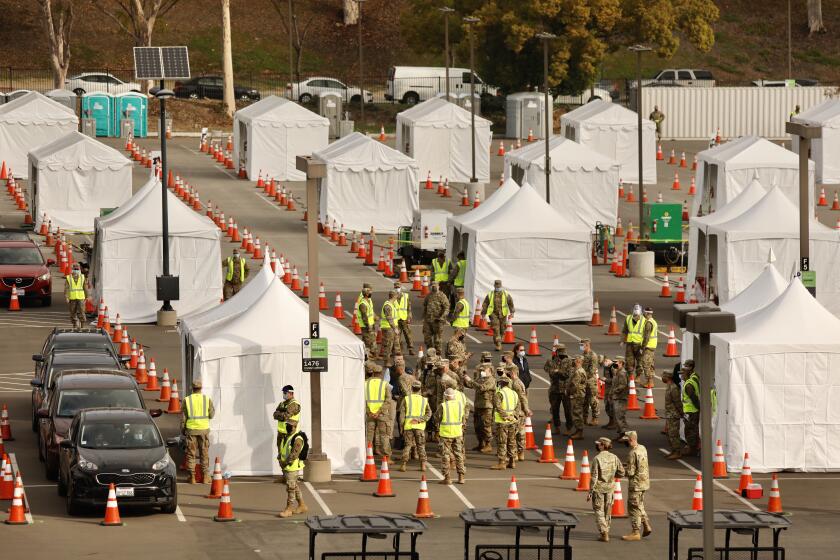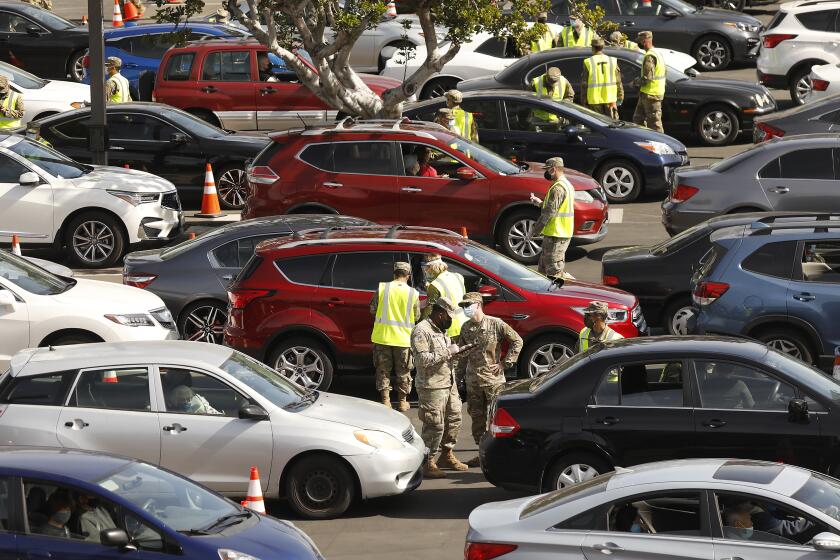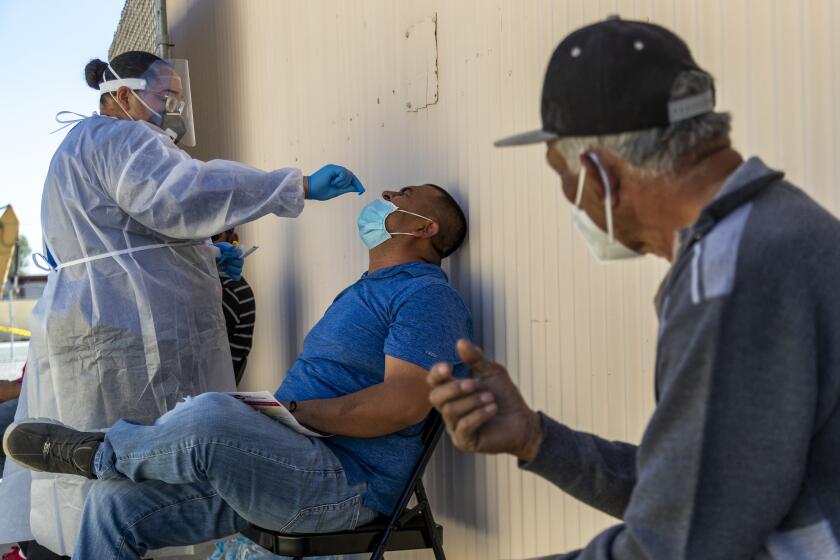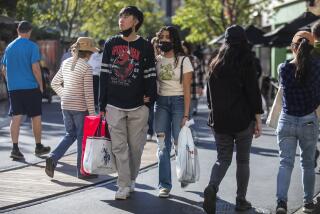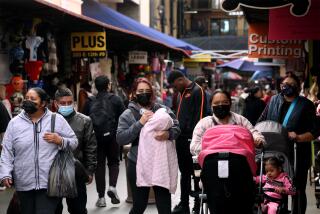Coronavirus cases plummet to pre-Thanksgiving levels. Are more reopenings next?
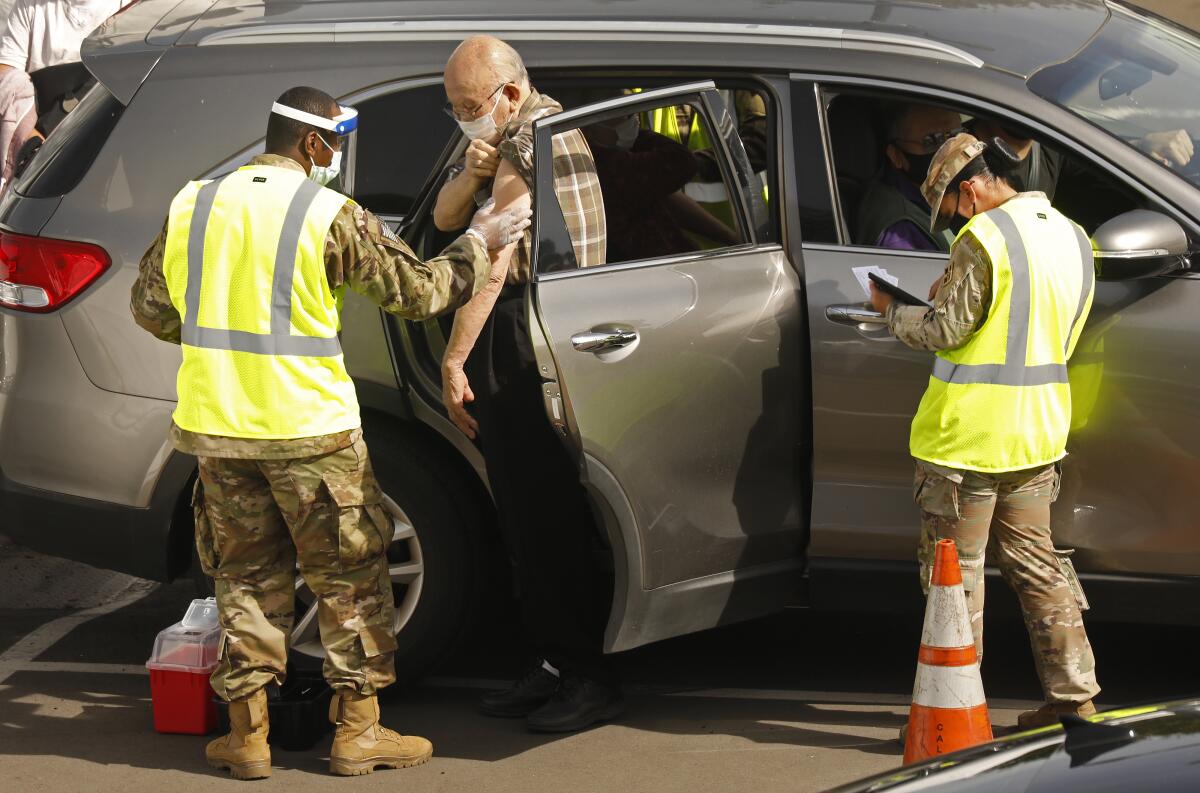
- Share via
Coronavirus infections have plummeted to pre-Thanksgiving levels in California, bringing renewed optimism that a wider reopening of the still-shackled economy may be just around the corner.
In a sign of how quickly conditions have improved following the devastating winter surge, Gov. Gavin Newsom hinted that more counties may emerge next week from what the state calls the purple tier — the strictest of California’s four-rung reopening roadmap for businesses and other public spaces.
“The good news — parts of the state are already beginning to open back up,” he said Tuesday. “Business is already starting to take shape — modified, nonetheless. We’re working hard to get our kids back in school.”
Even reverting to the tiered system is itself a sign of progress. The coronavirus was so rampant statewide as of a month ago that the framework remained on the shelf for much of California in favor of expansive regional stay-at-home orders.
All those orders were lifted in late January. Counties can gradually relax pandemic-related restrictions once their COVID-19 case numbers and testing positivity rates hit certain state-set benchmarks.
As it stands, 52 of California’s 58 counties remain in the most restrictive purple tier, meaning that indoor operations remain suspended or severely limited at many businesses and other public facilities.
Three counties — Del Norte, Mariposa and Plumas — have progressed to the less-stringent red tier, and another three — Trinity, Sierra and Alpine — have gone a step further, into the orange tier.
The most lenient yellow category remains empty at this point.
This week, Plumas County became the latest to move out of the purple tier, and Newsom said Tuesday that he expects that trend to continue.
“I anticipate a substantial number next week and even more in the subsequent weeks,” he said during an event to mark the opening of a new COVID-19 vaccination site at Cal State Los Angeles.
In recent weeks, L.A. County has had to limit appointments for first doses in order to ensure second shots can be provided to those who are due them.
That’s all dependent on whether the current trend lines continue, though. While health officials have cheered the state’s collective progress, they’ve continued to warn that California isn’t out of the woods yet — and that adherence to infection-prevention protocols such as wearing masks in public and avoiding crowded settings, particularly indoors, remains a must.
“These numbers continuing to decrease is not a given,” Los Angeles County Public Health Director Barbara Ferrer said Wednesday. “This will only continue if we’re all in the game, and we’re all using the tools we have at hand.”
Though the recent trends “are meaningful, and they’re all good news” Ferrer said public health officials are still keeping a watchful eye out for any signs of a potential uptick in cases stemming from gatherings and activities over the Super Bowl and recent holiday weekends. Such a rise, if it occurs, would likely start to materialize next week, she said.
Over the last week, California has reported an average of 8,087 new coronavirus cases per day — a level not seen since mid-November, according to data compiled by The Times.
That rolling average is down 53% from two weeks ago. The decline is even more dramatic when considering the worst peaks of the winter surge, when the state was recording nearly 45,000 cases a day.
The rate at which coronavirus tests are confirming infection has also nosedived — falling to 3.3% as of Wednesday. Just a few weeks ago, that statewide positivity rate was nearly 15%.
As new infections fall, so too do the number of people being hospitalized for COVID-19.
On Tuesday, 8,215 coronavirus-positive patients were hospitalized statewide. That’s the lowest total since Nov. 29, and down more than 60% from the height of the surge.
The story is much the same in California’s intensive care units, which were at times so deluged with COVID-19 patients that some officials openly wondered whether supplies and staff would be stressed to the point that care would need to be rationed.
Now, 2,439 COVID-19 patients are in California’s ICUs — a number not seen since early December.
Much of the credit for the recent declines, officials say, rests with residents and businesses who committed to following public health guidance, including by avoiding risky gatherings with those they don’t live with, properly wearing face coverings when outside their homes and, in the case of businesses, modifying their operations to enhance safety.
“We are in a very different place than we have been because of all of your hard work — each and every one of you doing your part,” Newsom said during a press briefing Wednesday.
None of this is to say the crisis has completely abated, however. Despite the steep decreases, hospitals are still caring for more coronavirus-positive patients than they did at any point prior to the latest surge.
“It is so much better today than it was just a month ago,” L.A. Mayor Eric Garcetti said Tuesday. “But even this level today in Los Angeles is triple, quadruple what it was at our lowest point in this pandemic.”
And the human cost of COVID-19, though also on the decline, still remains high. Over the last week, an average of 357 Californians have died from COVID-19 a day — pushing the pandemic’s total death toll past 47,500.
Some essential workers, teacher eligible for vaccine in L.A. County beginning March 1
Ferrer said earlier this week that the magnitude of the recent surge, for some, may have been “a wake-up call about the importance of really taking seriously the need for us to protect each other and to abide by the public health practices.”
“We’ve benefited from having everybody get back on track, doing their part to slow the spread,” she said. “These cases would not drop like this if we were continuing to see, for example, the actions that people were taking over the winter holidays.”
Another reason for the decline in L.A. County, she said, is that a significant number of residents already have some degree of protection against the coronavirus — either because they’ve been vaccinated or because they’ve already been infected.
The nation’s most populous county has long been the epicenter of California’s coronavirus outbreak. Despite being home to a fourth of California’s population, the county has accounted for roughly a third of the state’s confirmed cases, with about 1.17 million people testing positive, and about 40% of documented COVID-19 deaths, with more than 19,200.
However, officials believe the true infection count is likely much higher than what testing has confirmed. County scientists estimated last month that 1 in 3 Los Angeles County residents have been infected with the coronavirus since the beginning of the pandemic.
“I do think we have less people that are likely to get infected — people who were infected have some protections, as do people who are vaccinated — and that does help us in slowing the spread,” Ferrer said.
But she added that she believes the most important reason transmission is declining is because “people are back in the game and doing their very best to help each other. And we’ll need to keep doing that for the next few months in order to stay on a recovery journey.”
California’s vaccine rollout is missing millions who work in risky conditions, and it’s unclear when those with less visible jobs can get inoculated.
Though things are trending in a positive direction, progress is not inevitable, and officials and experts warn that California could easily change course if too many people or businesses eschew public health guidance.
Another worry is the documented presence of coronavirus variants in California — including one first identified in Britain that is believed to be 50% more transmissible and another first found in South Africa that has health officials concerned because the current COVID-19 vaccines are generally believed to be less effective against it.
Ferrer said Wednesday that four additional cases of the U.K. variant, known as B.1.1.7, have been found in L.A. County, bringing the confirmed total to 12.
“It’s never been more important for each of us to keep distance and wear a mask whenever we’re out of our homes and around people we don’t live with,” she said.
More infectious variants, a still-limited vaccine rollout and the potential for increased intermingling as more businesses and public spaces reopen could combine to trigger yet another coronavirus wave in the spring, some experts warn.
One of the ways to stave off that possibility, officials say, is for residents and businesses to protect themselves, their loved ones and their patrons by following public health protocols.
“I do not believe that we should accept the inevitability of there being another surge,” Dr. Anthony Fauci, the U.S. government’s top infectious-disease expert, said during an appearance on “L.A. Times Today” this week. “We can prevent that by very carefully adhering to the public health measures that we speak about all the time — the universal masking, by doing physical distancing, by avoiding congregate settings, particularly indoor.”
“It could happen,” he continued later, “but it’s within our power to prevent it.”
More to Read
Sign up for Essential California
The most important California stories and recommendations in your inbox every morning.
You may occasionally receive promotional content from the Los Angeles Times.
